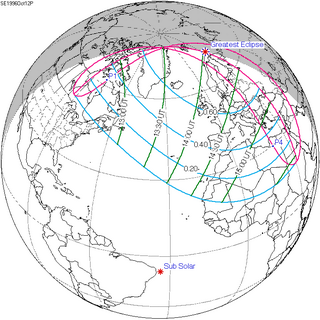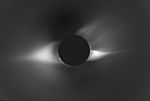Solar eclipse of October 12, 1996
| Solar eclipse of October 12, 1996 | |
|---|---|
 Map | |
| Type of eclipse | |
| Nature | Partial |
| Gamma | 1.1227 |
| Magnitude | 0.7575 |
| Maximum eclipse | |
| Coordinates | 71°42′N 32°06′E / 71.7°N 32.1°E |
| Times (UTC) | |
| Greatest eclipse | 14:03:04 |
| References | |
| Saros | 153 (8 of 70) |
| Catalog # (SE5000) | 9500 |
A partial solar eclipse occurred on October 12, 1996. A solar eclipse occurs when the Moon passes between Earth and the Sun, thereby totally or partly obscuring the image of the Sun for a viewer on Earth. A partial solar eclipse occurs in the polar regions of the Earth when the center of the Moon's shadow misses the Earth.
Images[]


Related eclipses[]
Eclipses of 1996[]
- A total lunar eclipse on April 4.
- A partial solar eclipse on April 17.
- A total lunar eclipse on September 27.
- A partial solar eclipse on October 12.
Solar eclipses 1993–1996[]
This eclipse is a member of a semester series. An eclipse in a semester series of solar eclipses repeats approximately every 177 days and 4 hours (a semester) at alternating nodes of the Moon's orbit.[1]
| Solar eclipse series sets from 1993–1996 | ||||||
|---|---|---|---|---|---|---|
| Descending node | Ascending node | |||||
| Saros | Map | Gamma | Saros | Map | Gamma | |
| 118 | 1993 May 21 Partial |
1.13720 | 123 | 1993 November 13 Partial |
-1.04114 | |
128 Partial from Bismarck, ND |
1994 May 10 Annular |
0.40771 | 133 Totality at Bolivia |
1994 November 3 Total |
-0.35216 | |
| 138 | 1995 April 29 Annular |
-0.33821 | 143 Totality at Dundlod, India |
1995 October 24 Total |
0.35176 | |
| 148 | 1996 April 17 Partial |
-1.05796 | 153 | 1996 October 12 Partial |
1.12265 | |
Metonic series[]
The metonic series repeats eclipses every 19 years (6939.69 days), lasting about 5 cycles. Eclipses occur in nearly the same calendar date. In addition, the octon subseries repeats 1/5 of that or every 3.8 years (1387.94 days). All eclipses in this table occur at the Moon's ascending node.
| 22 eclipse events between December 24, 1916 and July 31, 2000 | ||||
|---|---|---|---|---|
| December 24–25 | October 12–13 | July 31-Aug 1 | May 18–20 | March 7–8 |
| 91 | 93 | 95 | 97 | 99 |
| December 23, 1878 | October 12, 1882 | July 31, 1886 | May 18, 1890 | March 7, 1894 |
| 101 | 103 | 105 | 107 | 109 |
| December 23, 1897 | October 12, 1901 | August 1, 1905 | May 19, 1909 | March 8, 1913 |
| 111 | 113 | 115 | 117 | 119 |
 December 24, 1916 |
October 12, 1920 |  July 31, 1924 |
 May 19, 1928 |
 March 7, 1932 |
| 121 | 123 | 125 | 127 | 129 |
 December 25, 1935 |
 October 12, 1939 |
 August 1, 1943 |
 May 20, 1947 |
 March 7, 1951 |
| 131 | 133 | 135 | 137 | 139 |
 December 25, 1954 |
 October 12, 1958 |
 July 31, 1962 |
 May 20, 1966 |
 March 7, 1970 |
| 141 | 143 | 145 | 147 | 149 |
 December 24, 1973 |
 October 12, 1977 |
 July 31, 1981 |
 May 19, 1985 |
 March 7, 1989 |
| 151 | 153 | 155 | 157 | 159 |
 December 24, 1992 |
 October 12, 1996 |
 July 31, 2000 |
May 19, 2004 | March 7, 2008 |
| 161 | 163 | 165 | 167 | 169 |
| December 24, 2011 | October 13, 2015 | August 1, 2019 | May 19, 2023 | March 8, 2027 |
References[]
- Earth visibility chart and eclipse statistics Eclipse Predictions by Fred Espenak, NASA/GSFC
- ^ van Gent, R.H. "Solar- and Lunar-Eclipse Predictions from Antiquity to the Present". A Catalogue of Eclipse Cycles. Utrecht University. Retrieved 6 October 2018.
| Wikimedia Commons has media related to Solar eclipse of 1996 October 12. |
- Partial solar eclipses
- 1996 in science
- 20th-century solar eclipses
- October 1996 events



